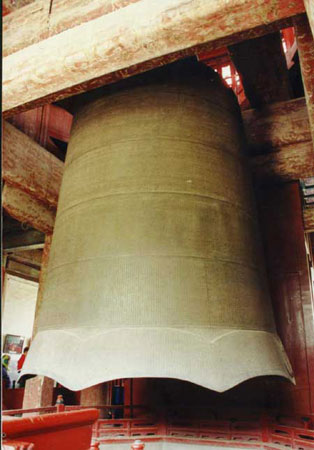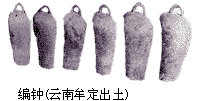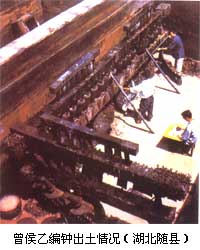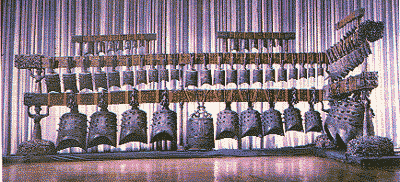Bell


There have been different stories concerning when the first Zhōng (钟,bell) came into being, yet everyone agreed that the first bell was made of pottery, as shown in the first picture above. It was excavated from Miaodigou of Shanxian County of Henan Province. The neolithic article is 9 cm in height and 5 cm in diameter, the sounding body is a cylender and the top is a round shaft.
Bronze bell appeared in the Xia Dynasty; during Shang Dynasty from 16th to the 11th centuries BC, there were different kinds of bells already.
When it came to the Zhou Dynasty, bell, as a metal instrument was ranked at the top of eight instruments, which was used at ceremonies at ancestor’s temple or at the king’s court.
A bronze bell, as shown in the second picture above, was discovered near Qinshihuang’s Tomb in Feburary, 1976. There are two characters—“Yuè Fǔ”—“conservatory” carved on the stem. It shows that as early as Qin Dynasty, there was already official conservatory. The sound of the bell is clear and pleasant with a high C.
Bells were divided into a “Single Bell” and a “Set of Bells” or Chime Bells, which are a group of bells of different sizes hanging on one wooded frame.
 When talking about a “Single Bell”, we have to mention
When talking about a “Single Bell”, we have to mention
Yongle Bell, which was casted during the Yongle period of Ming Dynasty. It is being hung in the Big Bell Temple at the western suburb of Beijing. It is also known as “the King of Ancient Bells.” The Bell was made of an alloy of copper, tin and lead. It is 6.94 meters in height, the diameter at the mouth is 3.3 meters and it weighs
46.5 tons. Its sound can still spread as far as 50 kilometers and the lingering
sound can last for two minutes. The thinnest spot at the wrist is 94 mm and the
thickest at the mouth is 185mm. 227,000 characters of regular script by Shen Du, a famous calligrapher of Ming Dynasty are on the surface of the bell; the casting of the bell reflected China’s high level technology in metallurgy and acoustics at the time.
Chime Bells first appeared in the Shang Dynasty, developed in the Western Zhou period, reached its peak at Spring and Autumn, Warring States periods and died out since Song Dynasty.

Chime Bells in the shape of Sheep’s horn, excavated from a tomb of Warring States period at Wanjiaba, Chuxiong of Yunnan Province.

Another set of chime bells excavated from Yunnan.
Chime bells excavated from the tomb of Marquis Yi of the State of Zeng

In 1978 a complete ceremonial set of 65 zhong bells was found in a near-perfect state of preservation during the excavation of the tomb of Marquis Yi, who died ca. 430BCE. Yi was ruler of Zeng, one of the Warring States which at the time of his death was under control of the Chǔ state. This region is now part of the present-day Hubei province. The picture on the left shows what it was like when they were first being discovered.
Although tuned bells have been created and used for musical performance in many cultures, zhong are unique among all other types of cast bells in several respects. They have a lens-shaped (rather than circular) section and the bell mouth has a distinctive "cutaway" profile, and this special shape gives zhong bells the remarkable ability to produce two different musical tones, depending on where they are struck. The interval between these notes on each bell is either a major or mino third, equivalent to a distance of four or five notes on a piano.
The bells of Marquis Yi -- which are still fully playable after almost 2500 years -- cover a range of slightly less than five octaves but thanks to their twin-tone capability, the set can sound a complete 12-tone scale -- predating the development of the European 12-tone system by some 2000 years -- and can play melodies in diatonicand pentatonic scales.
These bells have inscriptions on them. There are on the front such words: made by Marquis Yi of the State of Zeng, and on the back over 2,800 characters about musical terms and scales. 
This picture shows how the bells should be placed on the frame, which is 10.79 meters long, 2.67 meters high and weighs over 5 tons. Both ends of the frame has a copper casing for protection. There is one “Single Bell”, that was given to Marquis Yi at his death by the King Hui of Chu. Among 65 bells, 45 are with hanging shafts, they were tuned personally by the Marquis himself; they are placed at the lower and middle levels in 5 groups, the largest is 153.4 cm high and weighs 203.6 kilos; the rest 19 are placed at the top level in three groups, the smallest is 20.4 cm high and weighs only 2.4 kilos.
Famous Chime Bell Pieces:
1. 《Verse about Bamboo Branches》, which was originally a folk song of Sichuan area, yet, since Liu Yuxi, a Tang poet served there as a magistrate of Kuizhou, he wrote nine verses, the song became wide spread.
2. 《Flowers Under the Moon on the Spring River》
3. 《Qu Yuan Asked the Fisherman Questions》
4. 《Chu Songs in Shang Tunes》
5. 《The Silent Orchid》
